Importance of textile in the world
Hello to all of you, today I would like to tell you about the history, definition and importance of textile. And I want to tell and show what we do in this sector.
I would like to tell you about the history of the first chief textile.
__Turkish__
Hepinize merhaba, bugün sizlere tekstilin tarihini, tanımını ve önemini anlatmak istiyorum. Ve bizim de bu sektör’de neler yaptığımızı anlatmak ve göstermek istiyorum.
Sizlere ilk baş tekstil’in tarihçesinden bahsetmek istiyorum.
What is Textile?
This article, which contains more in-depth information about the history of textile, will provide us with real clues to learn what textile means, first of all. The word “textile” is derived from the Latin word “texere” meaning “weaving”. Textile refers to a flexible material made with a web of natural or artificial fibers known as yarn. Textiles are created by weaving, knitting, crocheting, knotting and interlacing fibers.
Tekstil Nedir?
Tekstilin tarihçesi hakkında daha derin bilgiler içeren bu yazı da öncelikli olarak tekstilin ne anlam ifade ettiğini öğrenmek, bize gerçek ipuçları hakkında fikir sağlayacaktır. “Tekstil” sözcüğü, “dokuma” manasına gelen Latin kökenli “texere” kelimesinden türetilmiştir. Tekstil, iplik olarak bilinen doğal veya yapay liflerden oluşan bir ağla yapılmış esnek bir malzemeyi ifade eder.
Tekstiller (textiles), dokuma, örme, tığ işi, düğümleme ve elyafların birbirine geçirilmesi ile oluşturulur.
Source
History of Textile
The history of textile is almost as old as human civilization. Textile has enriched itself as time progresses. B.C. In the 6th and 7th centuries, the earliest recorded indication of fiber use came with the discovery of linen and wool cloth in excavations of Swiss lake dwellers. In India, traces of silk culture can be traced back to A.D. It was found in 400 BC. In addition, traces of cotton material are found in BC. It dates back to 3000 years. In China, silkworm breeding and the discovery of the spin silk technique date back to the 4th century BC. It started in 2640. BC in Egypt In 3400, yarn linen and the art of weaving emerged. The discovery of various synthetic fibers such as nylon has created a wider market for textiles. Gradually improved natural fiber resources were discovered, transferred to a powerful system of transport and communication facilities. Localized skill between countries has led to the rapid progress of textile art.
Tekstilin Tarihçesi
Tekstilin tarihçesi neredeyse insan uygarlığı kadar eskidir. Tekstil kendini zaman ilerledikçe daha da zenginleştirmiştir. M.Ö. 6. ve 7. yüzyıllarda, fiber kullanımının kayıt altına alınmış en eski göstergesi, İsviçre göl sakinlerinin kazılarında keten ve yün kumaşın bulunması ile birlikte olmuştur. Hindistan’da, ipek kültürünün izlerine M.S. 400 yılında rastlanmıştır. Ayrıca pamuk maddesinin izleri ise M.Ö. 3000 yılına dayanmaktadır. Çin’de, ipek böcekçiliği ve spin ipek tekniğinin keşfi M.Ö. 2640’da başlamıştır. Mısır’da M.Ö. 3400’de iplik keten ve dokuma sanatı ortaya çıkmıştır. Naylon gibi çeşitli sentetik elyafların keşfi, tekstil ürünleri için daha geniş bir pazar yaratmıştır. Yavaş yavaş geliştirilmiş doğal elyaf kaynakları keşfedilmiş, taşıma ve iletişim tesislerinin güçlü bir sisteme aktarılmıştır. Ülkeler arasında yerelleştirilmiş beceri, tekstil sanatının hızlı bir şekilde ilerlemesine sebep olmuştur.

Export Share of Textile Industry in 2018
Source
Textile in Turkey
Turkey, which dates back to the Ottoman Empire and has a long history in textile production, continues to be an important country in the global textile and apparel industry. In 2017, the textile industry accounted for about four percent of the country's total exports. With this statistic, Turkey has become the fifth textile exporter in the world. The sector continues to show signs of growth without slowing down. The value of exported textile and apparel products has more than doubled since 2000. Most of the textile and ready-made clothing products produced in Turkey were imported by Germany, England, Spain and Italy. Thanks to these countries, which are in the top four in textile exports, the textile industry has reached serious figures. In 2016, Turkey exported over 10 billion dollars to these four European countries.
Türkiye’de tekstil
Osmanlı İmparatorluğu’na dayanan, tekstil üretiminde uzun bir geçmişe sahip olan Türkiye, küresel tekstil ve hazır giyim sektöründe önemli bir ülke olmaya devam etmektedir. 2017 yılında tekstil sektörü, ülkenin tüm ihracatının yaklaşık yüzde dördünü oluşturmuştur. Bu istatistik ile Türkiye, dünya sıralamasında beşinci tekstil ihracatçısı olmuştur. Sektör hız kesmeden büyüme belirtileri göstermeye devam etmektedir. İhraç edilen tekstil ve hazır giyim ürünlerinin değeri 2000 yılından bu yana iki kattan fazla artmıştır. Türkiye’de üretilen tekstil ve hazır giyim ürünlerinin büyük bir kısmı Almanya, İngiltere, İspanya ve İtalya tarafından ithal edilmiştir. Tekstil ihracatında ilk dört sırada yer alan bu ülkeler sayesinde tekstil sektörü ciddi rakamlara ulaşmıştır. Türkiye 2016 yılında bu dört Avrupa ülkesine 10 milyar doların üzerinde ihracat gerçekleştirmiştir.
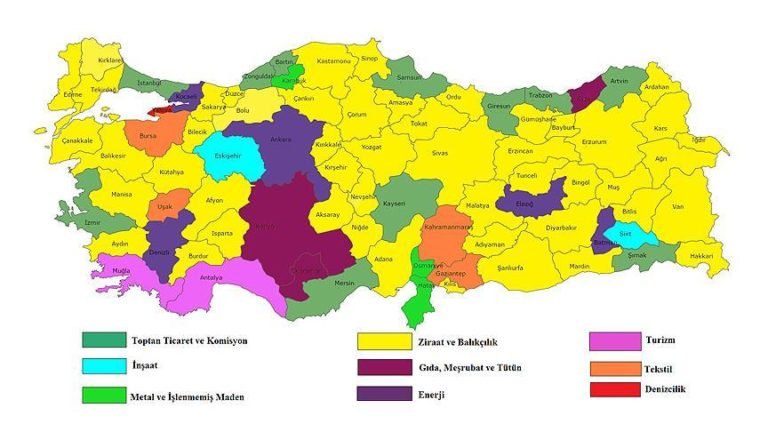
Turkey Economic Activity Map
Source
Textiles in India
Indian textile has a rich heritage. The origins of the textile industry in India can be traced back to the Indus Valley Civilization, where people began using household cotton to weave clothes. Rigveda, one of the oldest contents, contains literary information about textiles. This work contains artistic expressions about weaving. The Ramayana and the Mahabharata are outstanding Indian epics. These works also tell us about the existence of a wide variety of fabrics in ancient India. These epics refer to both an opulent garment worn by aristocrats and ordinary simple garments worn by ordinary people. Contemporary Indian textile not only reflects the glorious past but also meets the requirements of modern times. In addition, India continues to produce products that create global fashion in the field of
knitted fabric.
Hindistan’da tekstil
Hint tekstili zengin bir mirasa sahiptir. Hindistan’da tekstil sektörünün kökeni, insanların kıyafetlerin dokunması için ev pamuğunu kullanmaya başladıkları İndus Vadisi Medeniyeti’ne kadar uzanmaktadır. En eski içeriklerden olan Rigveda, tekstillerle ilgili edebi bilgileri içermektedir. Bu eser içerisinde, dokuma hakkında sanatsal ifadeler bulundurmaktadır. Ramayana ve Mahabharata, seçkin Hint destanlarıdır. Bu eserler de eski Hindistan’da çok çeşitli kumaşların varlığını bizlere anlatmaktadır. Bu destanlar, hem aristokratlar tarafından giyilen zengin bir giysiyi hem de sıradan insanlar tarafından giyilen sıradan basit kıyafetleri ifade eder. Çağdaş Hint tekstili sadece görkemli geçmişi yansıtmakla kalmaz, aynı zamanda modern zamanların gereksinimlerini de karşılar. Bunun yanında Hindistan, örme kumaş alanında küresel çapta moda yaratan ürünleri üretmeye devam etmektedir.
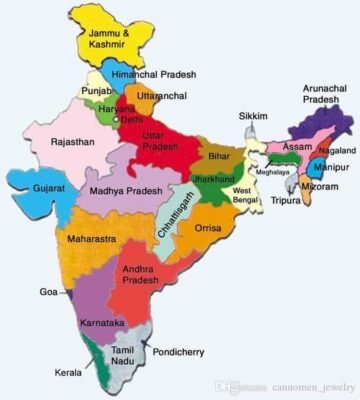
India Textile Map
Source
Textiles in Japan
In 1869, when the capital of Japan was Kyoto, it became Tokyo with an official decision. Since this date, the weaving tradition of the Nishijin Textile Center, which is the heart of Japanese textiles, has faced the danger of extinction. With the Industrial Revolution, Nishijin weavers integrated modern technology into their ancient textile arts. This practice started to grow with the new capitalist economic policies of Japan in 1890. The textile art of Japan during the Edo period and subsequent Meiji periods (1868-1912) displayed a cultural diversity and remarkable artistic skill. Japan has aimed for excellence in the field of textiles and continues to work towards achieving this goal.
Japonya’da tekstil
1869’da Japonya’nın başkenti Kyoto iken verilen resmi bir karar ile Tokyo olmuştur. Bu tarihten itibaren Japonya tekstilinin kalbi olan Nishijin Tekstil Merkezi’nin dokuma geleneği yok olma tehlikesiyle karşı karşıya kalmıştır. Sanayi Devrimi ile birlikte Nishijin dokumacıları modern teknolojiyi kendi eski tekstil sanatlarına entegre etmişlerdir. Bu uygulama, 1890’da Japonya’nın yeni kapitalist ekonomi politikalarıyla beraber büyümeye başlamıştır. Japonya’nın tekstil sanatı, Edo dönemi ve bunu izleyen Meiji dönemlerinde (1868 – 1912) kültürel bir farklılık ve dikkate değer bir sanatsal beceri sergilemiştir. Japonya tekstil alanında mükemmelliği kendisine hedef almış ve bu hedefe ulaşma yolunda çalışmalarını
sürdürmektedir.
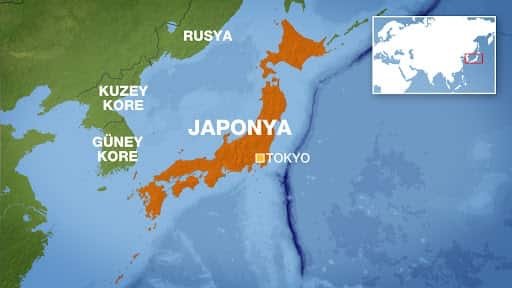
Japan Textile Map
Source
Textile in China
China has an excellent legacy in the textile industry. It has reached a significant market share in the global textile trade in the past and today. Chinese textile is an integral aspect of its heritage, with its world-renowned quality and deep symbolic meanings. Textiles symbolically reflect Chinese tradition and culture. Textiles in China are often closely associated with well-being. This sector has a place in the rituals of the market. The extraordinary love of parents for their children is reflected in the excellent clothes that are gifted to children at traditional festivities. These garments are made by blending expensive materials and excellent craftsmanship.
Çin’de Tekstil
Çin, tekstil sektöründe mükemmel bir mirasa sahiptir. Geçmişte ve günümüzde küresel tekstil ticaretinde önemli bir pazar payına ulaşmıştır. Çin tekstili, dünyaca ünlü, kaliteli ve derin sembolik anlamları ile mirasının ayrılmaz bir yönünü oluşturur. Tekstil, Çin geleneğini ve kültürünü sembolik olarak yansıtmaktadır. Çin’de tekstil genellikle refahla yakından ilişkilidir. Bu sektör piyasanın ritüellerinde yer edinmiştir. Ebeveynlerin çocuklarına olan olağanüstü sevgisi, geleneksel şenliklerde çocuklara hediye edilen mükemmel kıyafetlerle yansıtılmaktadır. Bu giysiler, pahalı malzemeler ve mükemmel işçilikle harmanlanarak yapılmaktadır.
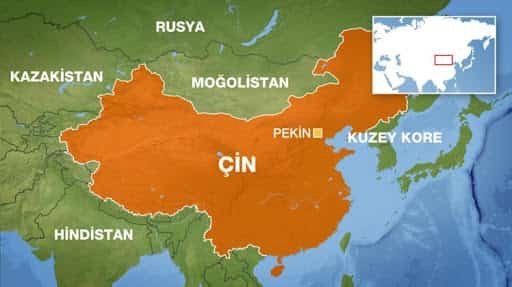
china textile map
Source
Textiles in Africa
In ancient times, textiles developed in Africa in an interesting way. A type of cloth was used as currency. The width of the fabric strip is standardized in every region of Africa. This cloth was distributed equally by the tribal chiefs for use by all for medicinal purposes. The natives had a limited number of standard-length strips of fabric to make bandages. This fabric, which is found in the same amount for everyone, later started to be used as a currency. Cloth emerged as a convenient form of money because it was used by everyone, highly durable and easily divisible. African weavers, dyers and other textile artists have worked together to create an elegant and surprising range of textiles. They played an active role in the development of textile. Textiles belonging to African culture embody various styles. Adinkara, kente, and bogolan are some of the increasingly popular African textiles. African textiles also feature styles that are not well .
known globally and are referred to by terms such as yoruba, ase-oke and adire.
Afrika’da tekstil
Antik çağda, Afrika'da tekstiller ilginç bir şekilde gelişti. Para birimi olarak bir tür kumaş kullanılmıştır. Kumaş şeridin genişliği, Afrika'nın her bölgesinde standardize edilmiştir. Bu kumaş, kabile reisleri tarafından herkesin tıbbi amaçlar için kullanması için eşit olarak dağıtıldı. Yerlilerin bandaj yapmak için sınırlı sayıda standart uzunlukta kumaş şeridi vardı. Herkeste aynı miktarda bulunan bu kumaş daha sonra para birimi olarak kullanılmaya başlandı. Kumaş, herkes tarafından kullanıldığı, son derece dayanıklı ve kolay bölünebilir olduğu için uygun bir para biçimi olarak ortaya çıktı. Afrikalı dokumacılar, boyacılar ve diğer tekstil sanatçıları, zarif ve şaşırtıcı bir tekstil yelpazesi yaratmak için birlikte çalıştılar. Tekstilin gelişmesinde aktif rol oynadılar. Afrika kültürüne ait tekstiller çeşitli stilleri bünyesinde barındırmaktadır. Adinkara, kente ve bogolan, giderek daha popüler hale gelen Afrika tekstillerinden bazıları. Afrika tekstilleri ayrıca dünya çapında pek bilinmeyen ve yoruba, ase-oke ve adire gibi terimlerle anılan stiller
içeriyor.
Okuduğunuz için teşekkür ederim. Sağlıcakla kalın
üretmeyedevam eddevam etmektedir.
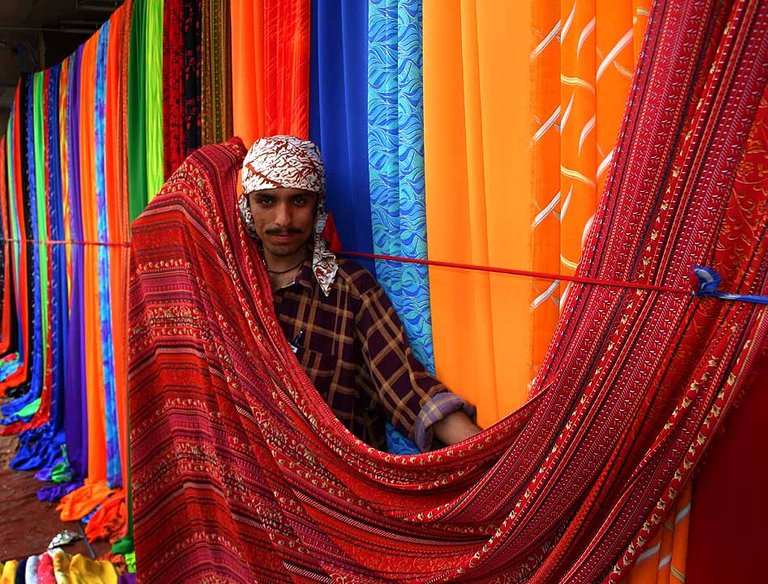
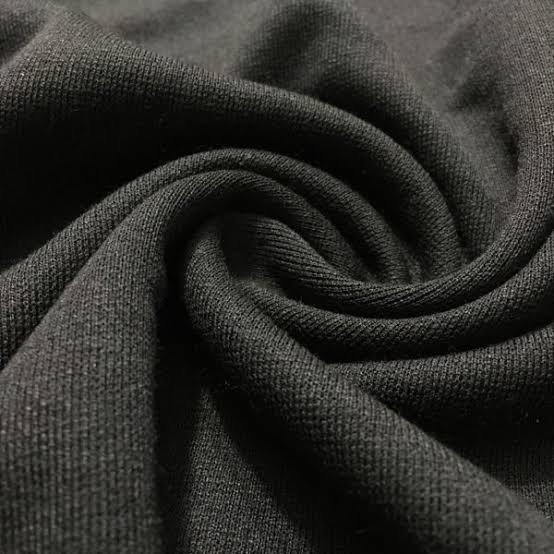
Congratulations @favian! You have completed the following achievement on the Hive blockchain and have been rewarded with new badge(s):
Your next payout target is 50 HP.
The unit is Hive Power equivalent because post and comment rewards can be split into HP and HBD
You can view your badges on your board and compare yourself to others in the Ranking
If you no longer want to receive notifications, reply to this comment with the word
STOPTo support your work, I also upvoted your post!
Check out the last post from @hivebuzz:
Support the HiveBuzz project. Vote for our proposal!
Waaww good post✌️ I get lots of information about textile.